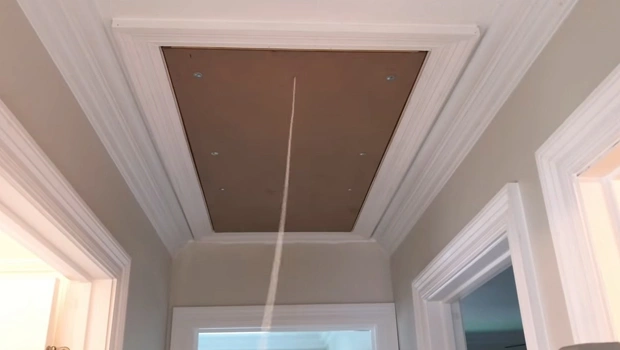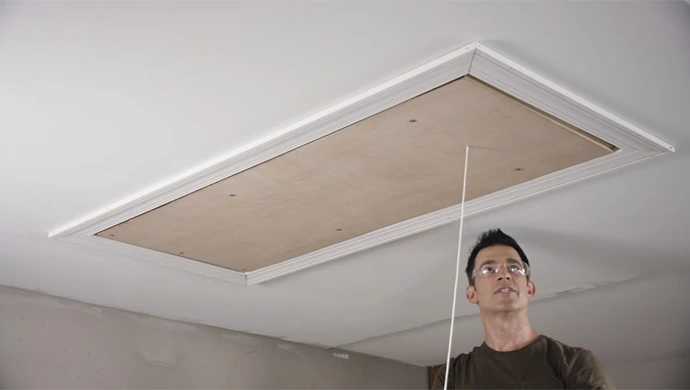Last Updated on November 1, 2022
In most houses, an attic entrance is located in the ceiling, often covered with a simple and unassuming cover. You can make your room appear more spacious and attractive by concealing the door in the ceiling. This technique is often used in commercial spaces, such as offices and retail stores.
You can give your room a clean and polished appeal by obscuring an attic door. It’s a simple change that can make a big difference. Hiding an attic door in the ceiling can help to reduce noise levels and upgrade the appearance of your room.
There are a few different ways to hide an attic ceiling door, including painting, decorative lights, and unique door coverings. You should get a quote for materials before starting the project, regardless of which path you take. Read on for details about widely used methods for masking an attic ceiling door.
How to Hide a Ceiling Attic Door : Methods

Attic doors are often an eyesore, especially if they’re low quality or poorly fitting. So it is pretty necessary to hide the entrance to increase the room’s aesthetic value. If you want to disguise your attic door, there are a few things you can do:
Decorate with Paintings or Art that Match the Ceiling Color
One way to camouflage a ceiling scuttle attic door is to decorate it with paintings or unique art that match the ceiling texture & color. This will help the door blend in with the rest of the ceiling and make it less noticeable.
This will help to create the illusion that the door is simply a part of the wall, making it much less noticeable. Of course, this isn’t always easy, as ceilings are often a different color than the walls. Even so, it is possible with patience and careful planning.
You’ll need to select a paint color that closely matches the shade of your ceiling. Once you have the perfect color, all you need to do is apply a few coats to the door, being careful to avoid any drips or streaks.
Using Attic Door In-Ceiling Decorations
If your Ceiling Attic Door is in an area where it might be seen, you can use in-ceiling decorations to help hide it. These come in different designs and colors, so you should be able to find something that will match your existing home décor.
This includes things like pictures, mirrors, and even plants. By hanging these items in the entranceway, you can effectively camouflage them and make them much less noticeable. Of course, you’ll need to be careful not to block the door completely, as this could make it difficult to access the attic when required.
To install them, simply affix them to the ceiling around the door opening. Once they’re in place, you can paint them or add other decorations to help them blend in. By planning, you can easily use decorations to conceal a ceiling attic door and simultaneously add a touch of style to your home.
Choose a Door Cover that Matches the Ceiling Texture
It can be tricky to conceal an attic door in the ceiling but choosing a cover that mimics the texture of the ceiling can make the process much easier. This will effectively disguise the door and make it unnoticeable.
If you have a textured ceiling, you’ll want to choose a door cover with a similar texture. It will make the door cover look like it belongs on the roof. Different techniques can be used to match the textures, so you’ll need to experiment to find the best way for your particular door cover and ceiling.
Once you have found the right cover, simply follow the instructions on the package to install it. In no time, your attic door will be well hidden, and your ceiling will have a beautifully uniform appearance.
Use a Decorative Light Fixture to Cover the Door

Ceiling attic space doors are often bulky and unattractive and can also be challenging to reach, making them a significant eyesore. One way to hide a ceiling attic access door is to install decorative lighting.
By suspending a beautiful light fixture from the ceiling, you can visually conceal the door while also adding elegance to the space. Choose an institution that is slightly larger than the door itself. Ensure the fixture casts adequate light and is proportionate to the door size. Then, place the fixture in front of the door.
Install a Sliding Door for a Streamlined Appearance
One popular way to streamline the appearance of a ceiling attic access entryway is to install a sliding door. Sliding doors are available in various styles and materials, so you can find one that matches the rest of your décor.
It is possible to purchase sliding doors at most home improvement stores for a reasonable price. Installing a sliding door is a simple process achievable in a few hours with minimal tools and experience. A sliding door will help hide your ceiling attic door and give your home a sleek and modern look.
Build a Recessed Attic Door for a Flush Finish
If you’re looking for a way to conceal your ceiling attic door, a recessed option may be a perfect choice. These doors sit flush with the ceiling, giving your attic a clean and finished look. Recessed doorways are also great for preventing dust and debris from entering the attic storage space.
You can start by measuring the space where your door will go. You’ll need to know the width, height, and depth of the opening to purchase the correct size door. Once you have the measurement, cut out a piece of drywall to fit the opening. Ensure that the drywall fits snugly against the edges of the gap before proceeding.
Next, install framing around the perimeter of the drywall using wood screws or nails. This will support the drywall and help keep it in place. Now it’s time to install the door itself. To install hinges, screw or nail them onto the door’s top and bottom. Next, secure the door with screws or nails in the opening.
Building a recessed attic hatch door is a great way to hide an unsightly ceiling attic door and provide your home with a polished look. With a bit of time and effort, you can build a recessed access door that gives your home a flush finish.
Hide the Door’s Pull Cord for a More Cohesive Look
Hiding the cords for your ceiling attic door can give your space a more cohesive and polished look. Several methods exist that can accomplish this. One option is to use cord clips to attach the cords to the back of the door frame.
Alternatively, you can purchase cord covers positioned along the baseboard or trim. If you’re feeling handy, you could also build a simple cover for the cords using wood or another material. Whatever method you choose, hiding the cords is a relatively easy method of enhancing the overall aesthetic of your space.
Hang Curtains or Drapes that Match Indoor Furniture
The last option for hiding an attic access panel is to simply drape or hang curtains that complement the indoor furniture. This will give the space a more finished look and help to draw the eye away from the door. Be sure to choose curtains or drapes made of light-colored fabric.
Hanging curtains or drapes is a quick and easy solution for camouflaging an attic ceiling door. And, if you choose curtains or drapes that complement your interior design, you will achieve a pulled-together look.
These are some simple and effective strategies for hiding ceiling attic doors. Following one of these suggestions, you can make your space more attractive and cohesive.
What to Think Before Hiding Ceiling Attic Door?

Most people don’t give much thought to their ceiling attic door. But if you’re thinking about hiding it, you should consider a few things first. The most important thing is making sure that the door is still accessible.
If you’re planning on using the space for storage, you’ll want to be able to get to it quickly. In contrast, if you’re just trying to hide the door for aesthetic reasons, you can make it more difficult to access.
A poorly insulated door won’t make a difference in energy efficiency if it is not well protected. Take into account the overall style of your home. If you have a more traditional decor, a hidden door may stick a sore thumb.
If you’re hiding the door behind a piece of furniture, be sure to leave enough space around it so you can still get to the door. You should also make sure that there’s adequate ventilation in the area where the door is hidden. Otherwise, you run the risk of creating a fire hazard.
Be sure to tell your family or roommates the location of the hidden door in an emergency. By taking these precautions, you can safely hide your ceiling attic door without creating any hazards.
FAQs
The following are some frequently asked questions about hiding an attic door in the ceiling:
Q: What are some creative ways to hide a ceiling attic door?
There are a few ways to go about hiding an attic door. One way is to install a false ceiling directly over the opening so that the door is hidden from view. Another option is to hang a tapestry or other piece of fabric in front of the opening, which will obscure it from view. You could also add a decorative frame around the door, which would help to camouflage it.
Q: Can the attic door be hidden while still being accessible?
Yes, it is possible to have an attic access entrance that is hidden from view but can still be accessed. One way to do this is to have the door open upwards so that it is not visible from below. You can also have the door disguised as something else, such as a bookshelf or a piece of furniture.
Q: Are there any common mistakes people make when hiding ceiling attics?
In short, yes. The most notable is using the wrong attic insulation and not properly securing the insulation. Other common mistakes include not adequately sealing off the area outside the attic (which can lead to heat loss and drafts) and using too much or too little attic ventilation (which can cause condensation and mold).
Q: Should attic access be sealed when hiding?
Yes, attic access should be sealed to keep rodents, pests, and drafts from entering the home. Sealing attic access also helps improve energy efficiency and can prevent moisture damage. There are various ways to seal attic access, depending on what type of opening you have. You can use weatherstripping, caulk, expanding foam, or a door sweep.
Conclusion
While many homeowners are happy to display their attic door, others prefer to keep it hidden. There are several ways to achieve this, and the best option often depends on the style of the home and the surrounding decor. Hiding a ceiling attic access hatch can be a great way to improve your home’s appearance.
By following one of the methods we’ve outlined, you can hide the door without creating any safety hazards. We hope this article helped you understand how to hide a ceiling attic door. With a bit of creativity, it is easy to find a way to hide an attic door and keep your home looking neat and tidy.

